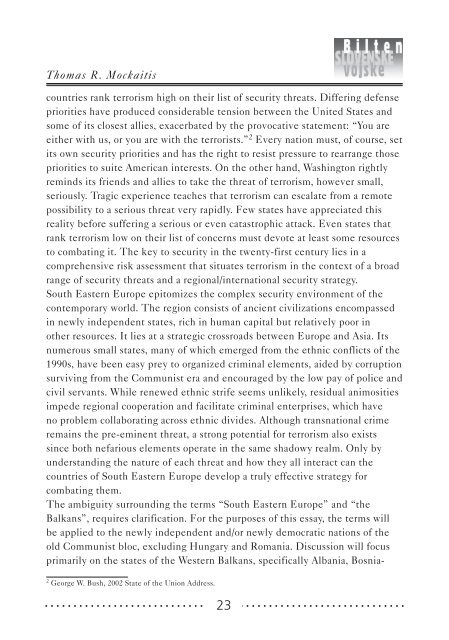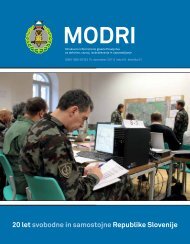bilten slovenska vojske.indd - Slovenska vojska
bilten slovenska vojske.indd - Slovenska vojska
bilten slovenska vojske.indd - Slovenska vojska
Create successful ePaper yourself
Turn your PDF publications into a flip-book with our unique Google optimized e-Paper software.
Thomas R. Mockaitiscountries rank terrorism high on their list of security threats. Differing defensepriorities have produced considerable tension between the United States andsome of its closest allies, exacerbated by the provocative statement: “You areeither with us, or you are with the terrorists.” 2 Every nation must, of course, setits own security priorities and has the right to resist pressure to rearrange thosepriorities to suite American interests. On the other hand, Washington rightlyreminds its friends and allies to take the threat of terrorism, however small,seriously. Tragic experience teaches that terrorism can escalate from a remotepossibility to a serious threat very rapidly. Few states have appreciated thisreality before suffering a serious or even catastrophic attack. Even states thatrank terrorism low on their list of concerns must devote at least some resourcesto combating it. The key to security in the twenty-first century lies in acomprehensive risk assessment that situates terrorism in the context of a broadrange of security threats and a regional/international security strategy.South Eastern Europe epitomizes the complex security environment of thecontemporary world. The region consists of ancient civilizations encompassedin newly independent states, rich in human capital but relatively poor inother resources. It lies at a strategic crossroads between Europe and Asia. Itsnumerous small states, many of which emerged from the ethnic conflicts of the1990s, have been easy prey to organized criminal elements, aided by corruptionsurviving from the Communist era and encouraged by the low pay of police andcivil servants. While renewed ethnic strife seems unlikely, residual animositiesimpede regional cooperation and facilitate criminal enterprises, which haveno problem collaborating across ethnic divides. Although transnational crimeremains the pre-eminent threat, a strong potential for terrorism also existssince both nefarious elements operate in the same shadowy realm. Only byunderstanding the nature of each threat and how they all interact can thecountries of South Eastern Europe develop a truly effective strategy forcombating them.The ambiguity surrounding the terms “South Eastern Europe” and “theBalkans”, requires clarification. For the purposes of this essay, the terms willbe applied to the newly independent and/or newly democratic nations of theold Communist bloc, excluding Hungary and Romania. Discussion will focusprimarily on the states of the Western Balkans, specifically Albania, Bosnia-2George W. Bush, 2002 State of the Union Address.23
















